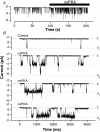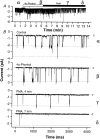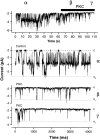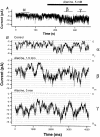Regulation of an inwardly rectifying ATP-sensitive K+ channel in the basolateral membrane of renal proximal tubule
- PMID: 9417142
- PMCID: PMC1887764
- DOI: 10.1085/jgp.111.1.161
Regulation of an inwardly rectifying ATP-sensitive K+ channel in the basolateral membrane of renal proximal tubule
Abstract
Functional coupling of Na+,K+-ATPase pump activity to a basolateral membrane (BLM) K+ conductance is crucial for sustaining transport in the proximal tubule. Apical sodium entry stimulates pump activity, lowering cytosolic [ATP], which in turn disinhibits ATP-sensitive K+ (KATP) channels. Opening of these KATP channels mediates hyperpolarization of the BLM that facilitates Na+ reabsorption and K+ recycling required for continued Na+,K+-ATPase pump turnover. Despite its physiological importance, little is known about the regulation of this channel. The present study focuses on the regulation of the BLM KATP channel by second messengers and protein kinases using membrane patches from dissociated, polarized Ambystoma proximal tubule cells. The channel is regulated by protein kinases A and C, but in opposing directions. The channel is activated by forskolin in cell-attached (c/a) patches, and by PKA in inside-out (i/o) membrane patches. However, phosphorylation by PKA is not sufficient to prevent channel rundown. In contrast, the channel is inhibited by phorbol ester in c/a patches, and PKC decreases channel activity (nPo) in i/o patches. The channel is pH sensitive, and lowering cytosolic pH reduces nPo. Increasing intracellular [Ca2+] ([Ca2+]i) in c/a patches decreases nPo, and this effect is direct since [Ca2+]i inhibits nPo with a Ki of approximately 170 nM in i/o patches. Membrane stretch and hypotonic swelling do not significantly affect channel behavior, but the channel appears to be regulated by the actin cytoskeleton. Finally, the activity of this BLM KATP channel is coupled to transcellular transport. In c/a patches, maneuvers that inhibit turnover of the Na+,K+-ATPase pump reduce nPo, presumably due to a rise in intracellular [ATP], although the associated cell depolarization cannot be ruled out as the possible cause. Conversely, stimulation of transport (and thus pump turnover) leads to increases in nPo, presumably due to a fall in intracellular [ATP]. These results show that the inwardly rectifying KATP channel in the BLM of the proximal tubule is a key element in the feedback system that links cellular metabolism with transport activity. We conclude that coupling of this KATP channel to the activity of the Na+,K+-ATPase pump is a mechanism by which steady state NaCl reabsorption in the proximal tubule may be maintained.
Figures














Similar articles
-
Properties of an inwardly rectifying ATP-sensitive K+ channel in the basolateral membrane of renal proximal tubule.J Gen Physiol. 1998 Jan;111(1):139-60. doi: 10.1085/jgp.111.1.139. J Gen Physiol. 1998. PMID: 9417141 Free PMC article.
-
An intracellular ATP-activated, calcium-permeable conductance on the basolateral membrane of single renal proximal tubule cells isolated from Rana temporaria.J Physiol. 2000 Mar 1;523 Pt 2(Pt 2):301-11. doi: 10.1111/j.1469-7793.2000.00301.x. J Physiol. 2000. PMID: 10699076 Free PMC article.
-
An ATP-regulated and pH-sensitive inwardly rectifying K(+) channel in cultured human proximal tubule cells.Jpn J Physiol. 2001 Aug;51(4):523-30. doi: 10.2170/jjphysiol.51.523. Jpn J Physiol. 2001. PMID: 11564289
-
ATP-sensitive K+ channels in the kidney.Naunyn Schmiedebergs Arch Pharmacol. 1996 Aug-Sep;354(3):213-25. doi: 10.1007/BF00171051. Naunyn Schmiedebergs Arch Pharmacol. 1996. PMID: 8878050 Review.
-
Cross-talk and the role of KATP channels in the proximal tubule.Kidney Int. 1995 Oct;48(4):1017-23. doi: 10.1038/ki.1995.384. Kidney Int. 1995. PMID: 8569062 Review.
Cited by
-
Potassium channels in epithelial transport.Pflugers Arch. 2003 Aug;446(5):505-13. doi: 10.1007/s00424-003-1075-2. Epub 2003 Apr 18. Pflugers Arch. 2003. PMID: 12707775 Review.
-
Basolateral membrane K+ channels in renal epithelial cells.Am J Physiol Renal Physiol. 2012 May 1;302(9):F1069-81. doi: 10.1152/ajprenal.00646.2011. Epub 2012 Feb 15. Am J Physiol Renal Physiol. 2012. PMID: 22338089 Free PMC article. Review.
-
Case studies in cholera: lessons in medical history and science.Yale J Biol Med. 1999 Nov-Dec;72(6):393-408. Yale J Biol Med. 1999. PMID: 11138935 Free PMC article. Review.
-
The beta1 subunit of Na+/K+-ATPase interacts with BKCa channels and affects their steady-state expression on the cell surface.FEBS Lett. 2009 Oct 6;583(19):3109-14. doi: 10.1016/j.febslet.2009.08.039. Epub 2009 Sep 1. FEBS Lett. 2009. PMID: 19729011 Free PMC article.
-
Expression of a functional Kir4 family inward rectifier K+ channel from a gene cloned from mouse liver.J Physiol. 1999 Feb 1;514 ( Pt 3)(Pt 3):639-53. doi: 10.1111/j.1469-7793.1999.639ad.x. J Physiol. 1999. PMID: 9882736 Free PMC article.
References
-
- Allard B, Lazdunski M. Nucleotide diphosphates activate the ATP-sensitive potassium channel in mouse skeletal muscle. Pflügers Arch. 1992;422:185–192. - PubMed
-
- Ashcroft SJ, Ashcroft FM. Properties and functions of ATP-sensitive K-channels. Cell Signal. 1990;2:197–214. - PubMed
-
- Beck JS, Hurst AM, Lapointe JY, Laprade R. Regulation of basolateral K channels in proximal tubule studied during continuous microperfusion. Am J Physiol. 1993;264:F496–F501. - PubMed
-
- Beck JS, Laprade R, Lapointe JY. Coupling between transepithelial Na transport and basolateral K conductance in renal proximal tubule [editorial] Am J Physiol. 1994;266:F517–F527. - PubMed
Publication types
MeSH terms
Substances
Grants and funding
LinkOut - more resources
Full Text Sources
Miscellaneous

